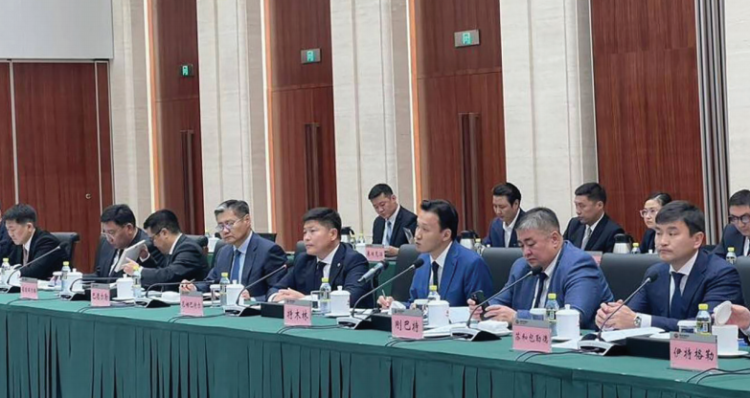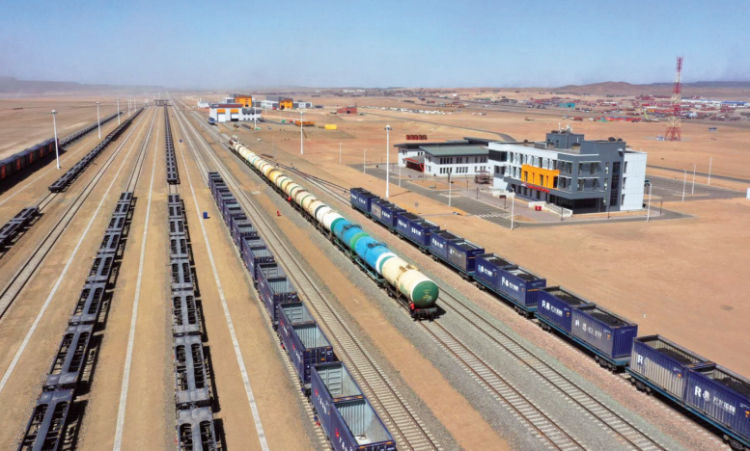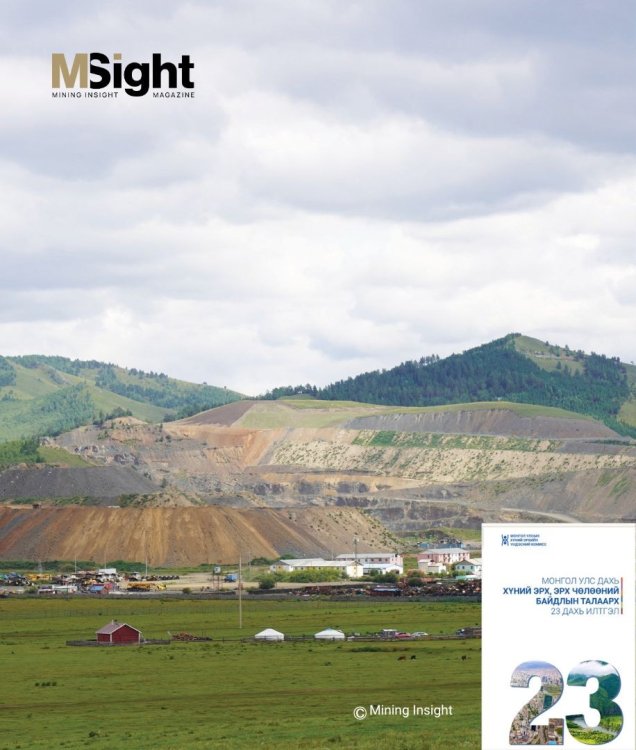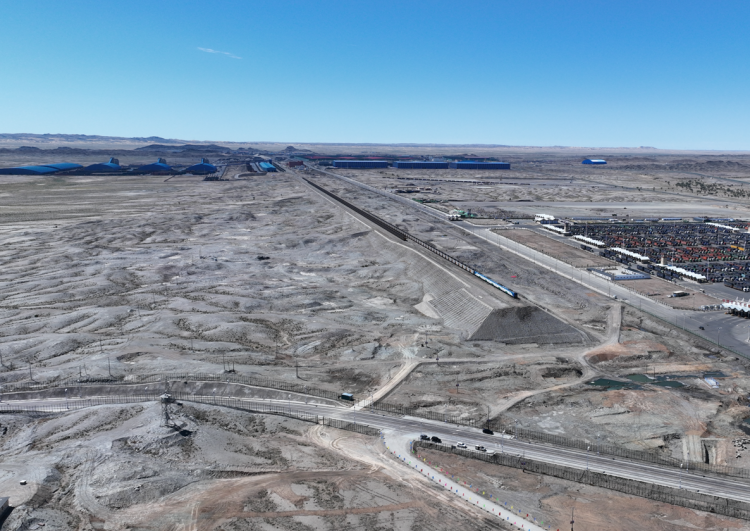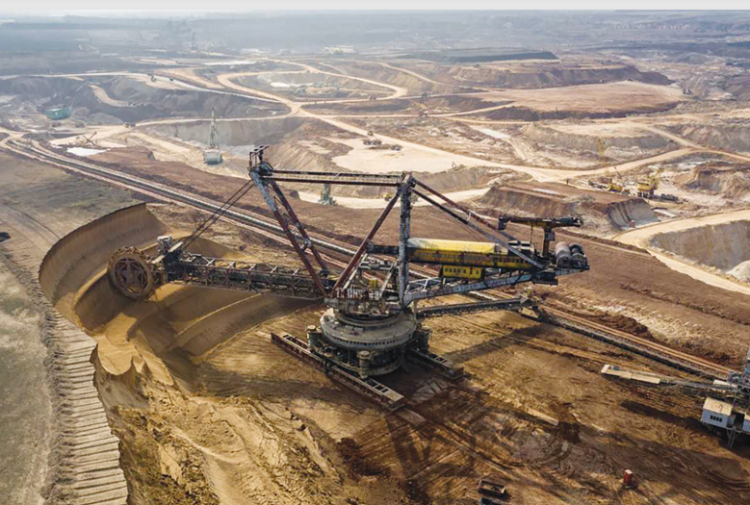od@mininginsight.mn

October brings high hopes to the Mongolian railway industry as we anticipate several significant developments. First, the completion of the Feasibility Study for the Gashuunsukhait-Gantsmod Port railway will pave the way for determining the construction costs and implementation timeline. Furthermore, the construction of the Shiveekhuren-Ceke port railway is set to conclude, and a railway cargo transshipment terminal will become operational at Khangi Port. Mongolia is also in the process of amending the Mongolia-China Border Railway Agreement of 1955 and the 2004 Agreement between the Governments of Mongolia and China on Border Ports and their Regime. These revisions are in connection with the operation of various port railways, reflecting Mongolia's commitment to enhancing its connectivity with its neighbor, China. In parallel, the upcoming 10th-anniversary summit of China's "Belt and Road" initiative, which will be attended by the Head of State of Mongolia, holds the promise of providing clear solutions to the crossborder railway issues between Mongolia and China.
The Prime Minister expressed that Mongolia is actively aligning with the People's Republic of China's "Belt and Road" initiative by opening four new export gateways during his opening speech at the Mongolia Economic Forum held under the slogan “Welcome to Mongolia”. In the next two years, our nation aims to establish a total of five export railway crossings, in addition to Zamyn-Uud, further enhancing its connectivity and trade opportunities. The "New Recovery Policy" encompasses a list of 100 projects set for implementation, including vital railway ventures like Tavantolgoi-Gashuunsukhait, Tavantolgoi-Zuunbayan, Zuunbayan-Khangi, Sainshand-BaruunUrt-Khuut, Choibalsan-Khuut, Khuut-Bichigt, and Bogdkhan railway projects. Among these, three railways have already been constructed, with the Tavantolgoi-Gashuunsukhait and ZuunbayanKhangi lines extending to the state border. The Prime Minister officially initiated the ChoibalsanKhuut-Bichigt railway project in July of the previous year. In accordance with the government's decision, construction on the Shiveekhuren-Ceke port railway commenced in the spring, with completion anticipated for this October. This development will establish a new gateway for Mongolia's exports by connecting the railways of Gashuunsukhait, Shiveekhuren, Khangi, and Bichigt ports with China's narrow-gauge railways. Presently, TT-GS transports coal from the mine to Gashuunsukhait station, with a gap of over 20 km between this point and Gashuunsukhait-Gantsmod port. The feasibility study and route map for the railway section in this area are being developed by China Railway Desigh Corporation, and their completion is scheduled for October. Following the approval of the feasibility study, the overall cost of the port railway will be determined.
Our side will cover expenses up to the Mongolia-China border point, amounting to USD 300 million, financed from the sales revenue of "Erdenes Tavantolgoi" without the need for an offtake agreement. To achieve this, ETT intends to supply 20 million tonnes of coal annually to the Chinese company "China Energy" under a mutually beneficial, stable, and market-principled long-term contract. Minister of Justice and Home Affairs Nyambaatar. Kh remarked, "One of the key objectives established during the Prime Minister's visit to China is the commitment to a long-term coal supply of 20 million tonnes annually to China Energy via the Tavantolgoi-Gashuunsukhait railway line." He highlighted the additional advantage of being able to market energy coal. Furthermore, Nyambaatar explained during the parliamentary session that the remaining railway capacity would be available for private-sector cargo transportation. The TT-GS railway currently possesses a capacity of 25 million tonnes per year. However, the Working Group estimates that through port connections, the railways can potentially increase their capacity to 40-50 million tonnes. This commitment to supply 20 million tonnes to China Energy represents an augmentation of ETT's existing production and supply levels. In september Erdenes Tavantolgoi exported 20 million tonnes coal. With these figures in mind, ETT's coal production for the remaining period could approach 30 million tonnes. The working group from both countries convened in Beijing on September 22, 2023, to exchange viewpoints during the development stage of the feasibility study for the Gashuunsukhait-Gantsmod port railway. If construction commences by the first quarter of 2024, the port railway project is anticipated to have a construction duration of approximately 1.6 years. But there is also the problem of delay. On the Mongolian side, there are a lot of problems with facilities.
As it is a low-lying area, it is necessary to build a pair of bridges with a height of about 40 meters. Therefore, in addition to the detailed engineering experience, many types of permits are to be obtained from the border customs and other related organizations of the two countries. The parties agreed that the construction would be carried out by the Chinese state-owned company China Energy. According to task number 25 approved by the Ministry of Road and Transport Development, it is planned to build a cross-border railway with a length of 32.7 km, a wide and narrow gauge, and a bridge structure of 9.1 km. In the shortest time ever in Mongolia, the ZuunbayanKhangi railway was built within 11 months. The first railroad was laid on the border side with broad and narrow double gauge. In other words, the main line of the 13 km narrow-gauge railway from the border of Mongolia to Khangi station has been decided twice. In this way, the infrastructure ready for cross-border connection has been completed and is currently pending due to government-level negotiations. There is a railway with a capacity of 20 million tonnes, 8 km away from Mandula Port. As soon as the agreement between the two countries is confirmed, it has been reported that the Chinese side will build the missing part of the railway within a month.
A major task on the Mongolian side that should be done after the port railway connection is to include the KhangiMandula railway port in the 2004 agreement on border ports between Mongolia and China and their regime. Minister Nyambaatar. Kh recently presented that negotiations are ongoing to solve this within the following year. This issue was agreed with the Chinese side during the visit of our foreign minister last year. If all this goes ahead smoothly, a terminal will be opened in Khangi, where many types of cargo can be transshipped, not only mining. Gashuunsukhait and Khangi ports enjoy the strategic advantage of being near the primary Chinese market for Mongolian mineral products. Regarding Shiveekhuren, it serves as a pivotal port for exporting minerals from the Nariinsukhait group of deposits. Recent developments have underscored the strategic significance of designating Shiveekhuren port as the second gateway for our nation's foreign trade. Given that China represents 84 percent of Mongolia's exports, it is crucial to establish an alternative route for foreign trade connectivity, particularly by linking to the railway network connecting Asia and Europe, which is located over 100 km away from the ShiveekhurenCeke port. Consequently, the construction of the port railway has been expedited. The "Nariinsukhait Railway" company, jointly owned by "Mongolian Railway" (51%) and the private sector entity "Nariinsukhait Railway" LLC (49%), has undertaken the task of operationalizing the 7 km crossborder railway this October. After six years of use, this railway will be fully transferred to the state under a concession agreement. The Shiveekhuren-Ceke port railway, financed by the private sector, will integrate into the western vertical corridor. The government initially granted a special license to the private sector for the Nariinsukhait-Shiveekhuren railway line 15 years ago, which was part of the TT-GS route, but later the government decided to construct a 1,255 km railway spanning the Artssuuri-Nariinsukhait-Shiveekhuren direction. In July of the previous year, the Prime Minister inaugurated the Choibalsan-Khuut-Bichigt railway project extending to Bichigt port. He emphasized the project's strategic significance, stating, "The BichigtZuunkhatavch port will not only provide Mongolia but also Russia with the shortest route to China's sea. In essence, Bichigt is the focal point of the economic corridor connecting Russia, Mongolia, and China to the sea." There is an existing railway that connects the Russian Federation's Trans-Siberian Railway with Mongolia's Bayantumen station of the UBTZ. From there, a 415-kilometer railway line will be extended to Bichigt Port, effectively linking it to China's Zuunkhatavch Port, which further connects to China's northeastern market and the South Sea. The Southern Sea Passage serves as a global shipping gateway.
Consequently, this railway project will establish the shortest transit corridor between Europe and Asia, connecting Mongolia with the Trans-Siberian Railway and the railway network of China's northeastern region. According to MTZ, the Choibalsan-Khuut-Bichigt railway will be implemented through a public-private partnership, with foreign and domestic investors to be selected, and the construction is anticipated to span 3-5 years. In January 2004, China's State Council endorsed the strategy "Development of China's national railway network until 2020." Within six months of this strategy, the Governments of Mongolia and China signed the Border Port Regime agreement, leading to the establishment of railway border ports on the ZamynUud-Ereen, Gashuunsukhait-Gantsmod, Shiveekhuren-Sekhe, and Bichigt-Zuunkhatavch routes. Nearly two decades have passed since those events, marking the initiation of port railway construction in our country. Enkhbayar. N, a researcher, and economist at the Strategic Research Institute, expressed his views in an interview with Mining Insight magazine, stating, "Our nation has often failed to adhere to the protocols agreed upon by the governments of both countries, often disregarding China's proposal to connect Gantsmod port. Instead, Mongolia proceeded to construct the Tavantolgoi-Gashuunsukhait railway independently, resulting in a broader-scale project." For many years, discussions have revolved around the aspiration to connect all our border ports with railways.
However, concrete actions and preparations have been infrequent. The current scenario reflects an array of incomplete projects, unfinished initiatives, and endeavors that have commenced without comprehensive planning. If Mongolia fulfills its commitments, substantial progress can be made in establishing railway connections with China. China has meticulously planned and phased its infrastructure projects, including railways, adhering closely to their execution schedules. Historically, Gantsmod, Manula, Zuunkhatavch, Rashaant, and Ceke port railways have been completed and integrated into the national network. A decade ago, the 360-kilometer railway line from Gantsmod Port to the Bugat region commenced operations under the ownership of Shenhua, subsequently transitioning to China Energy Group. In 2019, the 214.5 km railway linking Zuunkhatavch port with Shanxi province was finalized. Two new railways were inaugurated to facilitate the transportation of raw materials from the central Xili area, bordered by Khangi and Bichig ports, to the South Sea. It extends to Suizhong Port in Liaoning Province. In 2021, the inaugural coal cargo was directly transported to Caofedian port via the extended railway network. In accordance with Chinese government policy, Mandal has undergone development as a cargo port since 2015. Last year, the 240 km railway connecting the port to Bugat was inaugurated. As part of a trial operation, Mongolian mining products imported via the Mandula port were transported to the Bugat region. Subsequently, in the 14th-year Port Development Plan of the People's Republic of China, Ereen was designated as a unified hub port, while Gantsmod and Sekhe were assigned as primary specialized ports. The plan envisaged the creation of dedicated gateways for importing 10 million tonnes of mineral products through Gantsmod, Ceke, and Mandula ports. It also aimed to establish the necessary infrastructure for launching the Mandal port railway, create a smart logistics center, and advance the development of railway ports including Gantsmod-Gashuunsukhait, Ceke-Shiveekhuren, and Zuunkhatavch-Bichigt.

This year marks the 10th anniversary of the Belt and Road Initiative. In 2016, the Heads of State from the three countries signed an agreement to align the efforts of China's Belt and Road Initiative, the Silk Road Economic Zone, Mongolia's Steppe Road, and Russia's Eurasian Economic Union. Under the "Economic Corridor" program, four railway corridors were delineated for development. The development of railway infrastructure in our neighboring countries underscores the significance of the Eastern Corridor. Mongolia's aspiration to become a "transit country," coupled with the shared interests of Russia and China in establishing a more efficient route, unites these three nations. During the visit of Chinese President Xi Jinping to our country, discussions revolved around transit transportation, utilizing Mongolia and China's territories for sea access, renewing the Mongolia-China border railway agreement, fostering railway transportation cooperation, and enhancing cooperation in railway transit transportation. Consequently, Mongolia gained the right to access seven sea ports open for foreign trade in northern and northeastern China: Dandong, Dalian, Jinzhou, Yingkou, Qinhuangdao, Huanghua, and Tianjin. At a regular meeting of the economic corridor, President V.V. Putin emphasized the significance of the Zuunbayan-Khangi railway. During the period of China's embargo on Australian coal imports, Russia augmented its exports to southern markets by enhancing its land ports with a combination of wide and narrow-gauge railways. At that time, the Russian Railways (RJD) sought the opportunity to utilize the Trans-Mongolian railway, as the broad and narrowgauge railway serving the Transbaikal-Manchurian port near Mongolia's Ereentsav port was unable to handle the volume of mineral exports. Approximately 50 percent of the main road connecting Altanbulag and Zamyn-Uud is under the ownership of RJD.
Another line from the Ulaanbaatar Railway (UBTZ) connects to the Trans-Siberian Railway at the Bayantumen station. The construction of the Choibalsan-Khuut-Bichigt railway is poised to establish a transit corridor. Russia, which has faced international sanctions due to the Ukraine conflict, aims to directly access the Chinese market via mainland ports. A prime example is the resumption of the project to expand the Starotsuruhaituisk-Heishantou railway border crossing, situated 200 km east of the Manchuria port. Notably, the Udokan deposit, which holds substantial copper reserves in the Transbaikal region, commenced economic operations with mining activities commencing in September. In close proximity to the El deposit, which is rich in copper, gold, silver, and iron, the Bystrinsky deposit was connected to the Trans-Siberian Borzya station, not far from the Erentsav port. Given the current geopolitical landscape, the importance of the Eastern Corridor, which traverses these three nations, is rising. Therefore, the matter of interconnecting railway networks across state borders is of paramount significance, not only for Mongolia but also for its neighboring countries.
Mining Insight Magazine, №09 (022)



